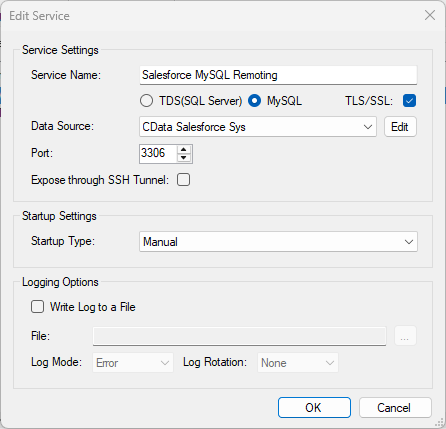Discover how a bimodal integration strategy can address the major data management challenges facing your organization today.
Get the Report →How to create Sage 200 federated tables in MySQL
Use the SQL Gateway and the ODBC Driver to set up federated tables for Sage 200 data in MySQL .
You can use the SQL Gateway to configure a MySQL remoting service and set up federated tables for Sage 200 data. The service is a daemon process that provides a MySQL interface to the CData ODBC Driver for Sage 200: After you have started the service, you can create a server and tables using the FEDERATED Storage Engine in MySQL. You can then work with Sage 200 data just as you would local MySQL tables.
Connect to Sage 200 Data
If you have not already done so, provide values for the required connection properties in the data source name (DSN). You can use the built-in Microsoft ODBC Data Source Administrator to configure the DSN. This is also the last step of the driver installation. See the "Getting Started" chapter in the help documentation for a guide to using the Microsoft ODBC Data Source Administrator to create and configure a DSN.
- Schema: Determines which Sage 200 edition you are connecting to. Specify either StandardUK or ProfessionalUK.
- Subscription Key: Provides access to the APIs that are used to establish a connection. You will first need to log into the Sage 200 API website and subscribe to the API edition that matches your account. You can do so here: https://developer.columbus.sage.com/docs/services/api/uk. Afterwards, the subscription key may be found in your profile after logging into Sage 200.
Configure the SQL Gateway
See the SQL Gateway Overview to set up connectivity to Sage 200 data as a virtual MySQL database. You will configure a MySQL remoting service that listens for MySQL requests from clients. The service can be configured in the SQL Gateway UI.

Create a FEDERATED Server and Tables for Sage 200 Data
After you have configured and started the service, create a FEDERATED server to simplify the process of creating FEDERATED tables:
Create a FEDERATED Server
The following statement will create a FEDERATED server based on the ODBC Driver for Sage 200. Note that the username and password of the FEDERATED server must match a user account you defined on the Users tab of the SQL Gateway.
CREATE SERVER fedSage200 FOREIGN DATA WRAPPER mysql OPTIONS (USER 'sql_gateway_user', PASSWORD 'sql_gateway_passwd', HOST 'sql_gateway_host', PORT ####, DATABASE 'CData Sage200 Sys');
Create a FEDERATED Table
To create a FEDERATED table using our newly created server, use the CONNECTION keyword and pass the name of the FEDERATED server and the remote table (Banks). Refer to the following template for the statement to create a FEDERATED table:
CREATE TABLE fed_banks ( ..., id TYPE(LEN), code TYPE(LEN), ..., ) ENGINE=FEDERATED DEFAULT CHARSET=latin1 CONNECTION='fedSage200/banks';
NOTE: The table schema for the FEDERATED table must match the remote table schema exactly. You can always connect directly to the MySQL remoting service using any MySQL client and run a SHOW CREATE TABLE query to get the table schema.
Execute Queries
You can now execute queries to the Sage 200 FEDERATED tables from any tool that can connect to MySQL, which is particularly useful if you need to JOIN data from a local table with data from Sage 200. Refer to the following example:
SELECT fed_banks.id, local_table.custom_field FROM local_table JOIN fed_banks ON local_table.foreign_id = fed_banks.id;






